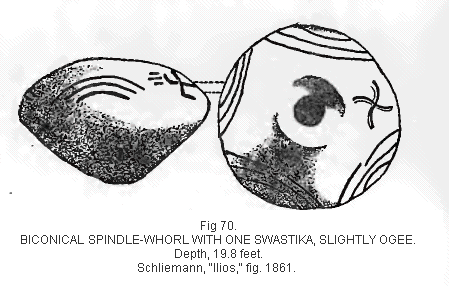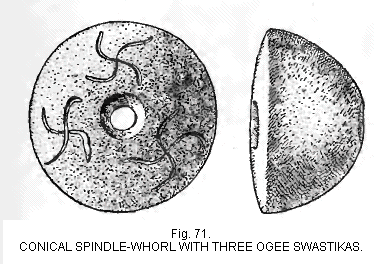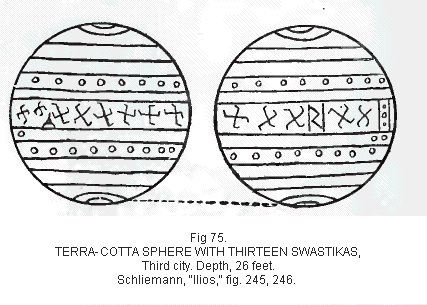

The Swastika
Dispersion of the Swastika

represents one Swastika in which the main arms cross at nearly right angles. Both ends of one arm turn to the left and those of the other arm turn to the right in figure 8 style. One of the ends is curved, the others bent at different angles. Fig. 70

shows the parallel lines representing segments of a circle similar to figs. 60, 64, 65 and 69, except that it has four instead of three. It has one Swastika; the main arms (of double lines) cross at right angles, the ends all curving to the left with a slight ogee.
The U. S. National Museum was, during 1893, the fortunate recipient of a collection of objects from Madame Schliemann, which her husband, before his death, had signified should be given to the United States as a token of his remembrance of and regard for his adopted country. He never forgot that he was an American citizen, and, preparing for death, made his acknowledgments in the manner mentioned. The collection consisted of 178 objects, all from ancient Troy, and they made a fair representation of his general finds. This collection is in the Department of Prehistoric Anthropology. In this collection is a spindle-whorl, found at 13 ½ feet (4 meters) depth and belonging to the fourth city. It had three Swastikas upon it’s face, and is here shown as fig. 71.
 (1)
(1)The Fifth City.–Schliemann says: (2)
The rude stone hammers found in enormous quantities in the fourth city are no longer found in this stratum, nor did the stone axes, which are so very abundant there, occur again here. In stead of the hundreds of axes I gathered in the fourth city, I collected in all only two here. * * * The forms of the terra-cotta whorls, too, are in innumerable instances different here. These objects are of a much inferior fabric, and become elongated and pointed. Forms of whorls like Nos. 1801, 1802, and 1803 [see figs. 72, 73, and 74],
 which
were never found before, are here plentiful.
which
were never found before, are here plentiful. The Sixth and Seventh Cities.–The sixth city is described in “Ilios,” page 587, and the seventh on pages 608 and 618. Both cities contained occasional whorls of clay, all thoroughly baked, without incised or pointed ornamentation, and shed no further light on the Swastika.
Fig. 75 represents the opposite hemispheres of a terra-cotta ball, found at a depth of 26 feet, divided by incised lines into fifteen zones, of which two are

ornamented with points and the middle zone, the largest of all, with thirteen specimens of
Zmigrodzki says (3) that there were found by Schliemann, at Hissarlik, fifty-five specimens of the Swastika “pure and simple” (pp. 809,826). It will be perceived by examination that the Swastika “pure and simple” comprised Swastikas of several forms; those in which the four arms of the cross were at other angles besides right angles, those in which the ends bent at square and other angles to the right; then those to the left (Burnouf and Max Müller’s Suavastika); those in which the bends were, some to the right and some to the left, in the same design; where the points tapered off and turned outward with a flourish; where the arms bent at no angle, but were in spirals each upon itself, and turned, some to the right, some to the left. We shall see other related forms, as where the arms turn spirally upon each other instead of upon themselves. These will sometimes have three, five, six, for more arms, instead of four (p. 768). The cross and the circle will also appear in connection with the Swastika; and other designs, and zigzags (lightning), burning altars, men, animals, and similar representations will be found associated with the Swastika, and are only related to it by the association of similar objects from the same locality. A description of their patterns will include those already figured, together with Schliemann’s
ENDNOTES:
1. “Ilios,” fig. 1852 [Back]
2. Ibid, p. 573. [Back]
2. Tenth Congr. Inter. D’Anthrop. Et d’Archaeol. Prehist. Paris, 1889, p. 474. [Back]
<< Previous Page Next Page >>
© 2004-2007 Northvegr.
Most of the material on this site is in the public domain. However, many people have worked very hard to bring these texts to you so if you do use the work, we would appreciate it if you could give credit to both the Northvegr site and to the individuals who worked to bring you these texts. A small number of texts are copyrighted and cannot be used without the author's permission. Any text that is copyrighted will have a clear notation of such on the main index page for that text. Inquiries can be sent to info@northvegr.org. Northvegr™ and the Northvegr symbol are trademarks and service marks of the Northvegr Foundation.

|